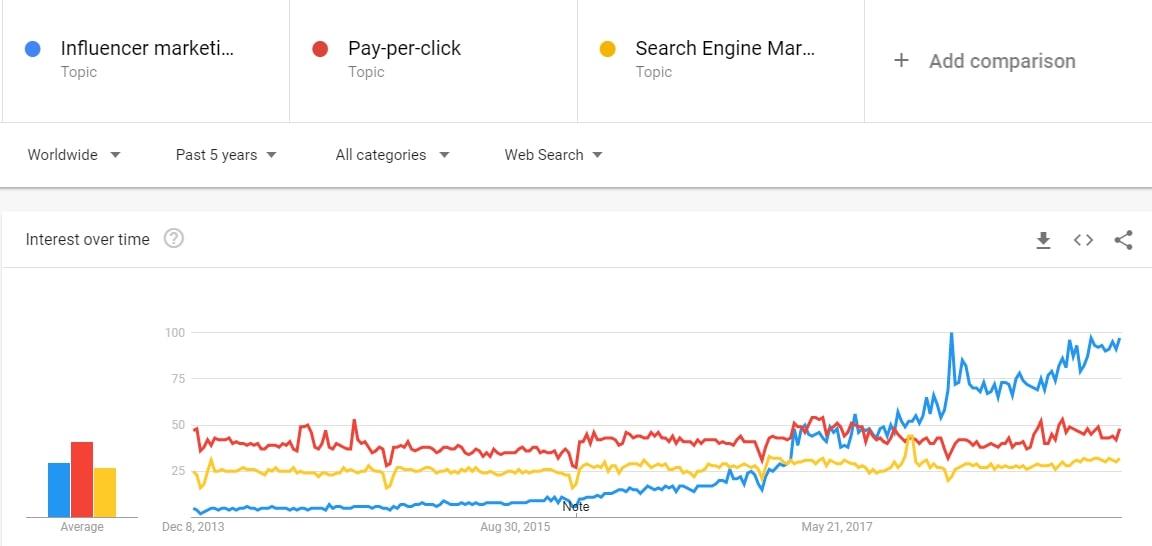
Attributing credit to marketing efforts has been the strife of marketers for decades. Luckily, we’ve gained a few tricks on our way and we can give you a great insight into the health of your campaign. In addition to this, with the key metrics available from industry leading tools, we can give you an even deeper look into your digital performance.
Traffic isn’t worth anything if users aren’t interacting in a way that is beneficial for your business. We track your website’s goals and optimise to make the completion of them more likely. For websites with high traffic we use A/B multivariate testing to isolate features that are holding back your goals. For smaller scale CRO we use tools like SessionCam to see how individuals are navigating around your page. There is always room for improvement and we look to squeeze every last bit of improvement out of your website.
The right KPIs (key performance indicators) can paint an accurate picture of your digital performance and inform future strategy. We’ll customise your reports to give you the most accurate representation of reality as possible. If you need a hand interpreting our performance reports we’ll be more than happy to give you a realistic explanation. Calculating ROI (return on investment) involves translating performance metrics into revenue. Although challenging, through clever attribution models and combining data sets we can give you reality driven assurances that your digital investment is paying off.
All useful information about your site lives here. Google Analytics is the perfect tool (in the right hands) to drill down into the data and mine precious insight that can be fed back into your online strategy.
Read more from our Digital Strategy Director, Tim, about predictive analytics.
Marketers can’t ignore the fact looking at data trends and how our society is evolving around technological advances influencer marketing is becoming a mainstream marketing channel.

The challenge for businesses is how to use it effectively to get the best return on investment avoiding the pitfalls that marketers can fall into when running influencer marketing campaigns for brands.
Brands must recognise at the moment influencer marketing is vunerable as a small percentage of influencers are trying to take advantage and cheat the system.
The giant company Unilever worth $62.62 billion dollars weighed in on their thoughts about influencer marketing
Keith Weed CMCO of Unilever is responsible for the marketing and communications gave a speech earlier this year at Cannes
“the industry has recognised that it must take a stronger stance on the integrity and transparency of influencer marketing”.
Luis Di Como, executive vice president for global media, Unilever
“I believe we are still in the early stages [of influencer marketing] and we need to continue working with influencers to see what measurement and success look like to create a mutual benefit partnership rooted in transparency and trust.”
With the rise of smartphones in the past 10 years users are impulse buying straight from their phones as a direct result from influencers.
“The average person in the UK spends more than a day a week online, according to a landmark report on the impact of the “decade of the smartphone”.
Ofcom, which compiled the report, attributes a large part of the surge in time online to the rise of smartphones, which are now used by 78 per cent of the population compared with just 17 per cent in 2008, the year after the first iPhone was launched.” Telegraph
What is a Social Media Influencer
An influencer is an individual that uses popular social media networks examples being Facebook, Instagram and Youtube to build credibility in their specific industry by creating authentic, engaging content for the influencers audience of followers.
Celebrity Influencers
Kylie Jenner has leveraged her fame as an influencer first appearing on the TV show “Keeping Up with the Kardashians”. The young entrepreneur makes an estimated $1 million per sponsored post on Instagram with a cool 120 million followers, she is currently worth $900 million dollars. However celebrity influencers have a lower engagement rate.
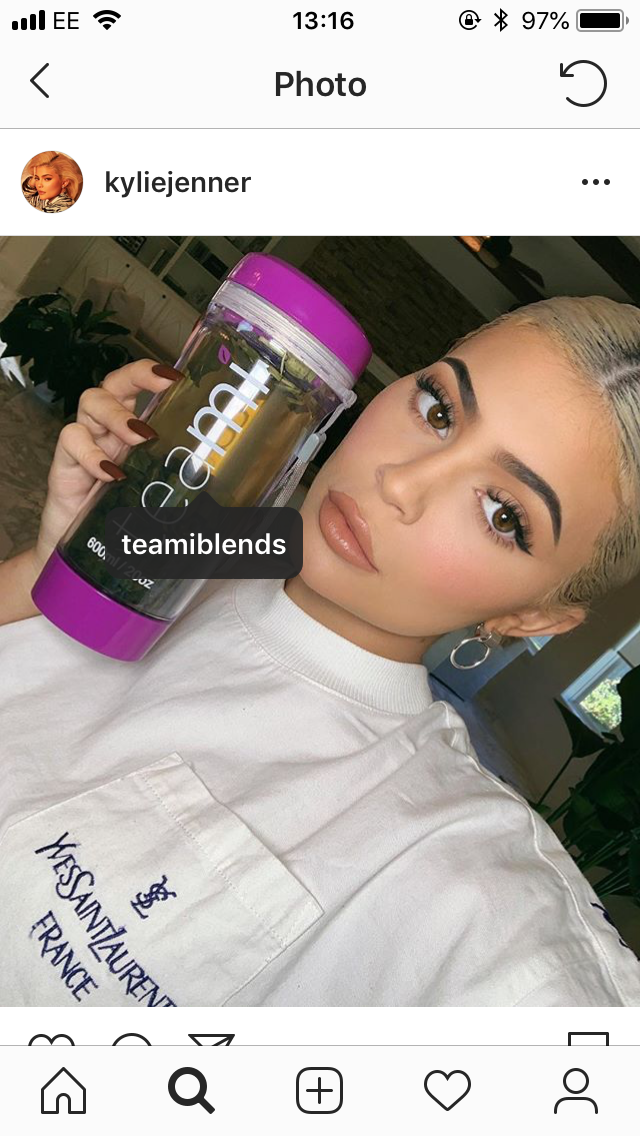
On the flip side micro-influencers have a much smaller audience between 1-100K but have a far higher engagement.
The Key Finding
When creating an Influencer marketing strategy an important variable to take into account is the age demographic whether that be for generation Z, millennials or generation X. They use social media channels and other online activities differently.
Gen Z
Marketers need to be open minded with Gen Z (13-24 year olds), according to Adweek
“The spending power is estimated at somewhere between $29 billion and $143 billion, easily eclipsing that of the millennial generation.”
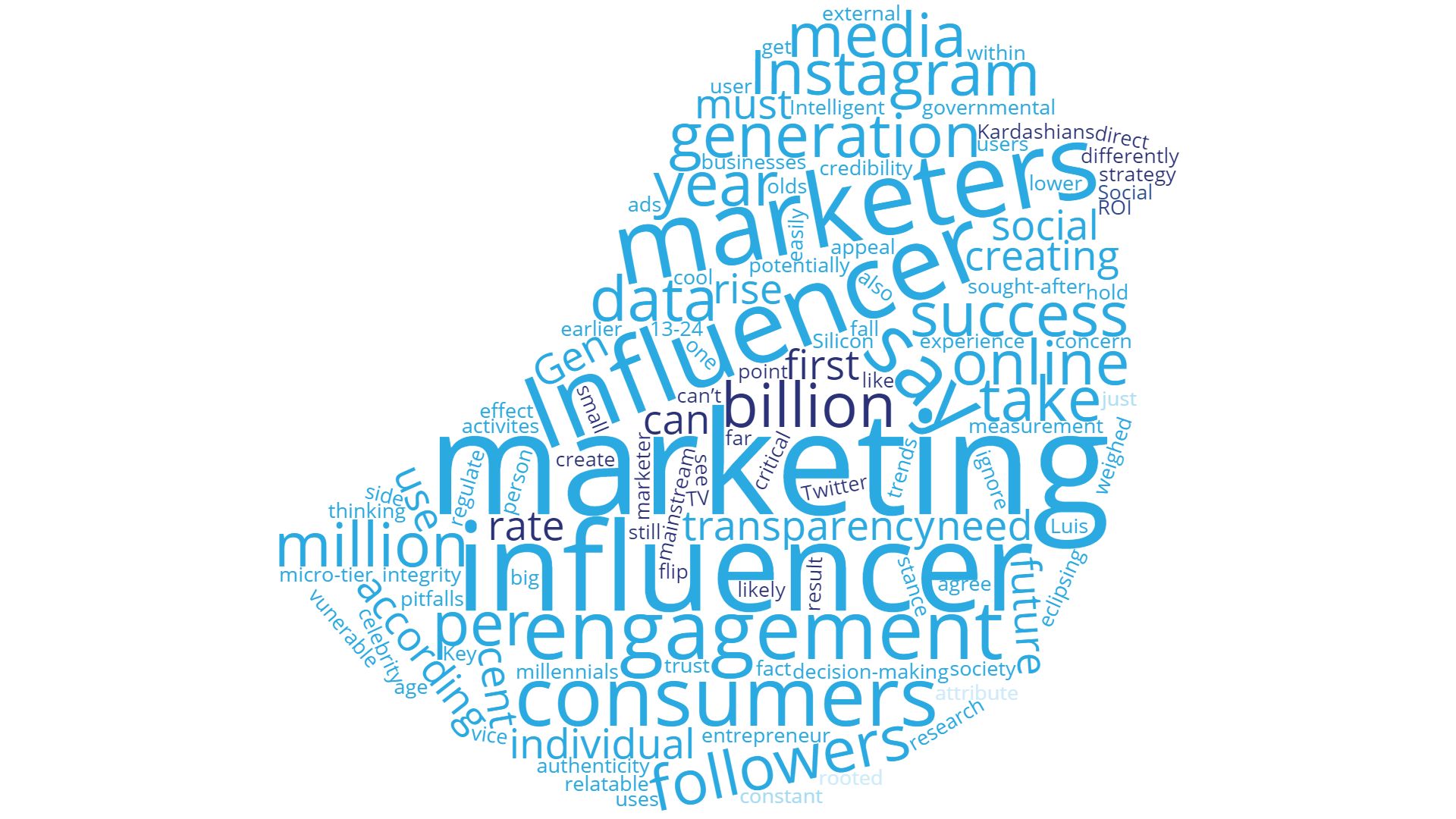
In a digital world that is growing at a rapid rate with the introduction of machine learning and AI research at Facebook, Instagram and Twitter. There are constant changes that effect these Silicon Valley companies whether that be algorithm updates, the inclusion of ads that can change the user experience or external factors where governmental bodies could potentially regulate these private companies in the future.
When it comes to planning your social media marketing strategy Facebook advertising has a proven track record to deliver measurable results at an affordable price to increase your sales giving you the peace of mind that investing in this paid advertising channel is suitable for businesses of all sizes.
Setting up a Facebook ads campaign uses a powerful targeting option allowing your business to be seen by thousands of people who have the ability to buy your product or service. You have the advantage of controlling your media budget.
The facts don’t lie Facebook is the world’s largest social media platform with over 2 billion worldwide monthly active users. UK stats show 45% of UK Facebook users check their account several times a day.
Facebook is set to make $4 billion with over 90% of Facebook’s advertising revenue now coming from mobile which shows businesses are adopting Facebook ads as a marketing channel.
Facebook is expanding its reach to advertise on the cross-platform messaging service for mobile devices WhatsApp.
General Facebook Statistics
(Facebook active users can be defined as those which have logged in during the last 30 days October 2018).
Why Facebook ads?
Looking at Facebook stats there is a high probability that your customer is already on the social media platform.
Ad targeting
You can target Facebook users by a number of different indicators to get a maximin ROI for example demographics.
Ads Targeted by Demographics
What Makes a Great Facebook Ad?
It must be visually compelling with a professional photo of the product. A picture tells a thousand words and when the ad is correctly structured it is likely to be remembered opposed to written ads.
The ad must be relevant to the end user. Facebook ads is built around the model of Cost Per Click (CPC). You spend money when a user clicks on the ad, so it has to be relevant to your target audience otherwise you are wasting money.
The ad must have a precise, focused call to action.
Example Call to Action buttons
Facebook Ad Formats
Facebook Business Pages Stats
60 million businesses have a business page worldwide
Top 10 Leading Brand pages on Facebook in the UK 2018
Facebook Competition
Ranked by monthly active users (millions)
From the data provided Facebook is the dominant social media network and should be included in your overall marketing strategy.
Facebooks ad platform is incredibly profitable if set up correctly and optimised.
Our digital marketing team is on hand to answer any of your questions.
Contact Us Today so we can help you grow your business.
Businesses are now having to incorporate an Instagram marketing strategy alongside other social media networks as a large segment of Instagram users are a potential buyer of the businesses product or service.
Instagram History
Instagram is a social media networking service allowing users to share photos and videos. The app was created in October 2010 by Kevin Systrom and Mike Krieger.
Mark Zuckerberg the CEO of Facebook saw the potential of Instagram and in April 2012 bought the company for $1 billion, with a user base of 30 million. The young start up company had 13 employees at the time with zero revenue coming in.
As of June 2018 Instagram has hit 1 billion users and is expected to amount $6 billion worth of advertising revenue in 2018, with some analysts predicting this number to increase to $20 billion by 2020.
Despite Facebooks recent setbacks regarding the public’s confidence in their privacy policy, data breaches, and fluctuating stock prices, advertisers haven’t shyed away from the platforms powerful influence it has on consumers.
There is an arms race between Facebook, Instagram and Snapchat as to how many minutes per day a user is spending on these social apps. In June 2018 new data from the online measurement company SimilarWeb was released.
“Instagram users in the U.S. spent nearly as much time in the Android app as Facebook users spent on their app.
On average, Instagram users spent 53 minutes per day with the Android app in June — just five minutes less than Facebook users spent with their app. Snapchat users spent 49.5 minutes in the Snap app, on average.”
Why a Business Should use Instagram Advertising
Instagram is currently the platform where specific businesses need to be found on when looking at paid search across the different social media platforms in regards to brand awareness, followers, engagement, driving business sales and generating leads. Instagram advertising has the potential to get your business ahead of your competitors.
“Instagramers look to be inspired, be creative, explore photos, videos and watch IGTV which includes content from brands and businesses on the social media network.
Instagram Audience
Interested in advertising your business on Instagram?
Our digital marketing team have a wealth of experience helping businesses with social media advertising in research, planning, creating original campaigns that deliver results for your business.
When it comes to local search marketing services pre internet one traditional way to search for a local service or product would be to reach for the yellow pages or local directory. Fast forward to today and for many people google is the default place to go to obtain information about services and products. One factor to help you increase local SERP for your website is to build local citations.
What is a Local Citation?
A local citation is any online mention of the name, address, postcode (NAP) and phone number for a local business. Citations can occur on local business directories, on websites and on social platforms. Citations help Internet users to discover local businesses and can also impact local search engine rankings. Local businesses can actively manage many citations to ensure data accuracy.
Citations can occur on:
Local generic business directories
Social and Review – oriented sites
Geo/Industry-Specific Niche Platforms
A business can look at building geographic and industry specific listing citations
An example citation directory of the restaurants industry in London
Across The Web
Local business citations can be built or earned by reaching out to a variety of publications such as blogs, news sites, maps, industry specific and government databases and accredited associations.
In addition to the essentional framework of a citation NAP name, address and postcode, citations can also include a number of other core features that enhance the user experience providing them with more information about the business.
The Most Important Citation Site Features
The state of Citations in 2018?
Local Search Experts
“The more prominent and consistent your business is online matters. When a search engine can see that you have more mentions than your competitors it only makes sense that this could affect the way the algorithm sees you as an entity. At the end of the day, getting citations done is a necessary evil. They are not as important as they were a few years ago, but the same thing holds true as it was back in the 90s. If you can get a link or a mention on a relevant website that your customers would care about, then go for it. The worst thing that can happen is you gain more traffic.” Ben Fisher
Google My Business (GMB)
Google has a specific feature when it comes to local search. Google my business is a free feature that make it easy for people to start building visibility in Google Search and Maps in your local community.
Core GMB listing Information
Business Name
For more information about Google My Business refer to the following article “Promote Your Business For Free With Google My Business Posts 2018″.
Our marketing department have a wealth of experience helping businesses improve their online presence through local marketing services.
More businesses in 2019 are including YouTube in their digital marketing strategy. The same marketing trend is occurring on other major social media networks – Facebook, Instagram, Snapchat and Linkedin.
Video content will account for 80% of all internet traffic by 2020. Video content gets up to 10x more reach and engagement compared to links and images
YouTube is increasing its international reach with a healthy audience due to the increased access to the internet for a number of reasons. Year on year first and developing world countries are spending billions of dollars in updating and building their national telecommunications infrastructure to increase broadband speed and reach.
The truth is that YouTube is the second largest social media platform after Facebook and it has broadly all the same generic features as other social media platforms and more:
Monthly active users:
YouTube Features
YouTube like all social media platforms can be used to link back to your site in numerous ways, helping to boost the traffic coming to your site as well as helping your SEO. YouTube videos are also indexed in the google search results
Let’s start with content. As with social media, you will need content for an audience to engage with. You have to create a “hook” at the start of the video. Your average viewer will decide to watch the video within the first 3-5 seconds due to the high volume of people watching video online and their short attention span.
70% of a videos performance will depend on how creative and authentic the content is.
Let’s start with content. As with social media, you will need something for an audience to engage with.
Where most people go wrong with YouTube content is that they try to make something that will go ‘viral’. In reality the chances of this happening are extremely slim. It is important to remember that just because you don’t have the biggest worldwide trending content doesn’t mean it isn’t attracting a new audience to your company.
Where most people go wrong with YouTube content is that they try to make something that will go ‘viral’.
Instead make something relevant. Whether it is a simple ‘how-to’ video, tutorials, unboxing, live streaming Q&A’s with your subscribers or something explaining your product or service, make sure that your brand comes across in a natural (and not too salesy) way.
Here are a few factors to consider when making your content:
YouTube can be a great place to advertise a product or service, it can persuade potential customers into buying your service over your competitors. So, make it something that stands out and get people engaged. Bring in you and your teams creativity or hire someone to help if you are not the creative type. Come up with something that will look great and get a relevant message across.
Like all of your content, your YouTube videos should reflect your business. So make sure that it has a clean professional look to it. It is worth investing some money and time into getting it right – you will still be spending a lot less than on a TV advert.
Once you have your content, there is more that you can do than just uploading it to YouTube. Here are few tips to get people to see the content you have created and use it to increase the traffic to your site.
Make sure that your videos are tagged to the right categories. YouTube does a great job of keeping its audience engaged, you will have probably noticed that you will be offered ‘related videos’ on the right-hand side of the page – take advantage of this. By making sure that your video is titled correctly and tagged to the right category your content can reach your target audience from similar videos they are already watching via related videos.
‘Favouriting’ other videos that align with your brand or product will mean that they show up on your channel, giving you a wider range of content on your channel homepage. Curating videos can be just as important as creating them so don’t be scared to share content from other brands that you align with.
The key objectives of creating content are to get people interested in your brand and onto your site. Your channel homepage can be linked back to the homepage of our site and the videos themselves.
Make sure that you have links in the description to lead potential customers back to site.
Annotations can also be added on top of the video at the end, again leading back to the site.
Make sure that if your video links to the relevant area of the site and not just the homepage. If the video is in reference to a certain product or service, make sure that it takes them directly to that page.
Your video shouldn’t just stay within YouTube. Post it on your website, share in on Facebook, Instagram, Linkedin, medium.com, Snapchat and Twitter, link to it from a newsletter – the more exposure it gets the more return you will get from it.
Now that you have content and few ideas for setting up your videos correctly we can move onto the bigger services that YouTube can offer your business.
YouTube offer a wide variety of advertising options including adverts after searches (similar to pay per click) and adverts before videos are played (pre-rolls). You can bid for YouTube keywords in the same way that you would bid on Google Adwords search network.
It is very easy to set up. All you will need is a video uploaded to YouTube, a Google Adwords account and then you are ready to launch your ad campaign.
Once you have everything set up you will be able to track your campaign with Adwords and the YouTube free analytics service, which lets you track the traffic your video gets as well as traffic generated from annotations.
If you want to learn more about getting started both YouTube and Google have produced fantastic guides for setting up your YouTube channel to help your business. If you would like to learn more about increasing your web presences don’t hesitate to give us a call on 01394 615 615 or email enquiries@infotex.co.uk
Thousands of digital marketers from around the world arrived for Brighton SEO with the knowledge they would have the privilege to learn and hear from the leading voices in the search marketing industry.
Again Kelvin Newman pulled off another successful and memorable search marketing conference.
It was great to meet, network and share ideas with digital marketing freelancers, executives, managers, CEO’s from agencies and passionate individuals who want to learn more about the industry and best business practices.
Of course, every year attendees love the goodies they get in their swag bags. Thanks to all the exhibitors and sponsors for their contributions.
There were many takeaways from the event, the overall trend is that SEO is still relevant more than ever and SEO will evolve over time adapting to new technologies, machine learning, A.I. and how humans will use the web in their daily personal and business life.
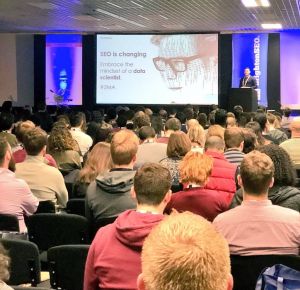
Chris from BrightLocal gave Infotex his summary of the days event:
“Every BrightonSEO is an invaluable source of knowledge and networking for the BrightLocal team, but this April’s conference was especially important for us. We’ve recently relocated to Brighton – and wanted to take this opportunity to really cement our position within the Brighton SEO community. It was great to sandwich the morning and afternoon sessions with a networking session – meeting loads of interesting digital marketers from Brighton, and further afield. We also made full use of having Greg Gifford in the UK – sending our newer recruits to his brilliant training session to brush up on local SEO (and 80s movies).
The sessions themselves were as interesting as ever – with a notable standout from Buzzsumo’s Steve Rayson and Brandwatch’s Giles Palmer exploring social sharing amid the content marketing boom.
It was also interesting to see reputation management gaining even more of the conference’s share of voice. We predict this will be one of the SEO trends most likely to grow in importance over the coming months.
A huge congrats to Kelvin for organising another excellent day – and making such a memorable entrance!”
Brightlocals chosen tweet of the day
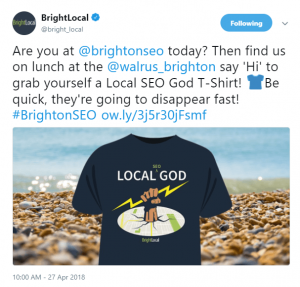
SEMrush
One of the tools the digital marketing team at Infotex use is SEMrush who gave us the following comment about the conference “We loved it, and as usual, it was a treasury of knowledge and an opportunity to meet with wonderful people”
SEMrush have compiled a detailed slideshare that contains the main highlights of the days conference.
Link Research Tools
I picked up a signed copy of “Spagetti Code” by Christoph C Cemper the founder of linkresearchtools.com for our digital marketing team.

Socialpubli.com
Lucila Rios from socialpubli talked to Infotex about micro-influencers. From socialpubli’s web site they highlight the importance of micro-influencers.
“At SocialPubli.com, we believe that we are all influencers. Today, it’s not just people who have millions of followers who help to win over consumers. It has also been proven that micro-influencers, ordinary people, can be a very important component in a marketing strategy.”
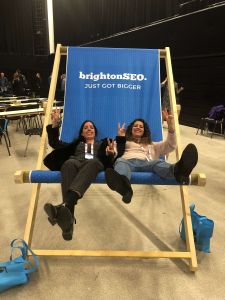
Pinterest is often overlooked as a website to boost your SEO rankings when considering digital marketing strategies. Pinterest is usually regarded as an inspirational site for those interested in food, interior design and fashion, but it’s so much more. If you aren’t using Pinterest, you could be missing out on an opportunity. With over 150 million users that continue to grow, here is your guide to using Pinterest to boost your SEO.
As with all websites and social media platforms, the content you produce needs to be good-quality and tailored to your audience. It’s no different with Pinterest. The backbone of the site is sharing new and unique content regularly. The SERPs monitor how many times a piece of content is shared, liked or re-pinned, so share content that’s unique, relevant or interesting. Pinterest provides a perfect platform to share blog posts, images, or products to help enhance your marketing strategy.
It’s important to make sure your business name is in the account name and username, along with a strong description about your company. Remember to include a number of searchable keywords, but don’t sacrifice quality; make sure it reads well.
Backlinks are an invaluable piece of SEO because search engines generate where your page ranks by considering the number of backlinks that lead people to your website. The more times your pin is viewed, the higher the backlinks to your website. You can even boost your backlinks further by inserting links into the captions of your photos and posts so that another backlink is created each time someone re-pins your image.
The trick behind keywords is finding the balance between not over-using them and using them effectively. Embrace the power of the #hashtag and use keywords in all of the descriptions of your pins. This will help increase your exposure on the web. You should also make sure your images are saved under your chosen keyword. An image won’t rank for “image2320”, but has a higher chance if it’s saved as its exact description.
Take advantage of Pinterest in-house analytics to track and analyse your progress so you can change your strategy in the future if needed.
If you’re interested in SEO strategies for your web design, then get in touch with us and we’d be happy to discuss all things SEO with you.
If you’ve got a good idea for an offer you want to run and are thinking about launching a pay per click campaign, one thing you’re going to need to do is create an effective landing page. Without one, your PPC campaigns may fall flat meaning you could lose out on revenue. Effective landing pages put emphasis on good design and compelling content writing. Above all else, it needs to grab the visitor’s attention and compel them to complete a conversion.

If the purpose of your landing page is to get people to follow through on your offer, you need to make sure your landing page is as clutter-free as possible. Any unnecessary details will draw attention from your message. If the landing page’s sole goal is to make your visitors convert then do what it takes to make their journey to conversion as easy as possible. If, for example, they need to fill out a form, ensure that you don’t have fields that aren’t needed. Strip everything down to the key elements and make sure it’s aesthetically pleasing. Good use of colour and eye-catching images have a surprisingly big impact. Studies have shown that using reds and greens work well for increasing landing page conversions, but ensure there is a good contrast between the button colour and your background.

If you have been promoting your offer well, through PPC campaigns, social media, Google AdWords and more, it’s highly likely that you’ll be receiving traffic from plenty of sources. Think seriously about customising your landing page for different audiences. It’s possible that a customer that has come to the landing page through Facebook knows a lot less about your offer than someone who is responding to a link in your email marketing campaign.

If your pay per click advertisements are driving your landing page, you’ll want to make sure that your copy is consistent. Repeating language and phrases that are in your PPC ads on your landing page helps to reinforce your message and adds to customer confidence. You need to be making sure that your page matches the advertisements as closely as possible. If your advertisement is about a specific product such as a pair of trainers, don’t send them to the sports clothing section – send them directly to the product they’re interested in.
For more information about how to create an effective landing page, contact the friendly team at Infotex today.
Delivering engaging, innovative content for your business is hard work, especially when you’re trying to sell a product or service. When you hit a creative roadblock it can be hard to know where to start. We’ve come up with some great ideas to kickstart your social media campaign, increase user engagement and build those all-important followers.
If you’re marketing a product, why not encourage your followers to showcase it? Open up a photography or video contest asking people to capture your product with a relevant hashtag. You’ll get lots of user-generated content you can then reuse: perfect for highlighting a new product launch, branding update or special offer!
Giving your followers something extra can really aid in loyalty and engagement. How-to guides are popular, giving customers an insight into your processes and can help your followers engage with your offering on a deeper level. Ask them to share the results of their project once they finish.
Remember Boaty McBoatface? Everybody loves to have their say. If you’re launching something new, hold a Twitter vote to give followers a say on its colour, name or function. They’ll be invested in the new product ready for launch and you’ll gain valuable feedback from the people who really matter.
Trending hashtags are perfect to instantly grab the attention of a whole new audience. You might choose to share some images for #mondaymotivation, have your say on #internationalwomensday or take part in the Ice Bucket Challenge. A little bit of research and your brand visibility can improve in an instant.
If your content is still feeling old, jump on to a platform that’s new to you. Show people around your office with Vine or capture your processes on Instagram. Or have a go at a feature you’ve been avoiding. Facebook Live is perfect for connecting in a meaningful way with your followers. There are new audiences everywhere – all you have to do is reach out to them.
For help planning your social media campaigns, get in touch.
Here at Infotex, we aim to offer the widest possible spectrum of digital marketing services.
You are probably already aware that we offer help with both website design and email marketing, for example. But did you know that certain website design techniques can be applied to marketing emails to improve the chances of recipients responding positively? While an email has a very different format to a website, they both need to be visually appealing and useful in order to succeed. Ergo, the techniques that are used to create one can often be applied to the other. In today’s blog, we’ll look at the website design techniques and strategies that can be deployed in your best email marketing campaigns.

Black-and-white textual emails are suitable for ordinary communication, but they aren’t very well adapted for marketing. In order to grab your recipients’ interest, you should utilise colour, just as you would on your website. Adding colourful, visual elements to your emails makes them more aesthetically engaging and encourages recipients to devote more time to reading them. What’s more, you can deploy the colours that you use across your business to reinforce your brand.

In addition to deploying an attractive colour scheme, you should also consider using images in your marketing emails. Images are very effective at drawing recipients in simply because, when people see an image, they instinctively want to understand what it’s about. An image can intrigue a viewer by making them consider its context. Including images on a web-page encourages visitors to read the text. Similarly, including them in an email increases the likelihood that it will be read thoroughly.

An important part of designing a website is ensuring that your viewers don’t become overwhelmed by data. Every well-designed website utilises areas of white-space so that viewers aren’t confronted with a solid wall of text and images. Emails should use white-space in the same way. Nobody wants to open a marketing email and see a solid block of text or images, so give your recipients some breathing room. This will make it easier for them to absorb your email’s contents and may encourage them to act on what they read.
If you need further assistance with either website design or email marketing, get in touch with us today. We’re always eager to help.
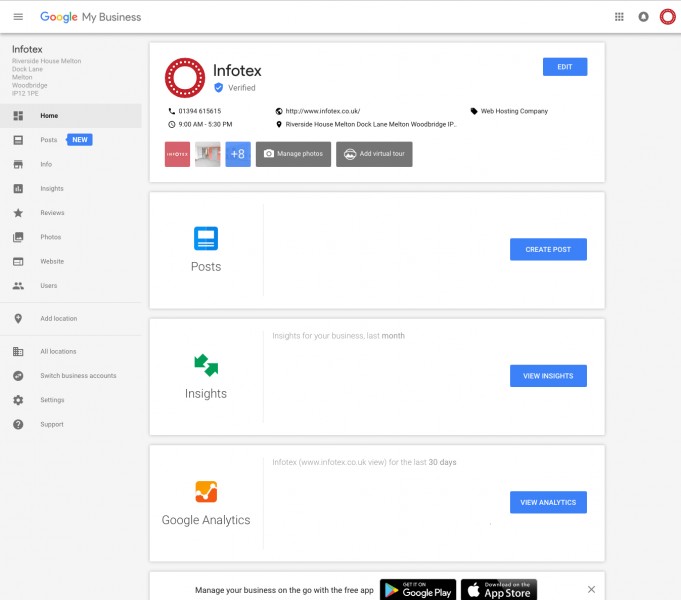
If you haven’t already got a Google My Business listing then what rock having you been living under!? It provides those searching for your business with all the important information they will need such as:
In addition to this, a Google My Business listing is essential to a website’s local SEO, especially those searching using local terms. Fully optimising your listing could help improve how your website ranks organically on Google for a whole array of search terms related to your business.
The best thing of all? It’s completely free!
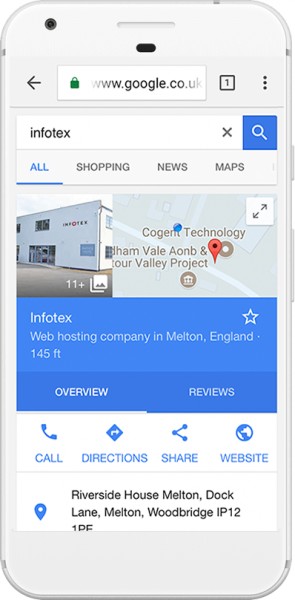
Posts is one of the latest features to be added and just another reason why your business should be taking full advantage of what a GMB listing could offer.
Recommended Factors to Optimise your Local Ranking on Google

The Posts feature in Google My Business allows companies to post an image with short write-ups accompanied by “calls to action” below in the form of buttons. The variety of opportunities that this gives small businesses to promote their product/service are endless –
Those three examples are just the beginning in how you could use Posts to market your business directly onto the Google search results page. These posts would also expand the size of your listing, a huge bonus due to the hypercompetitive nature of the Google SERP.
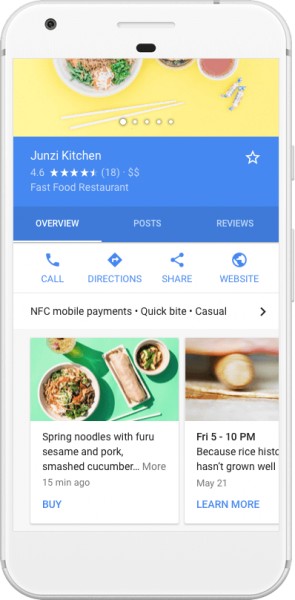
Once setup, there wouldn’t be any extra work involved in posting here if you are already using social media outlets such as Twitter/Facebook. This is the answer to the question “How can I promote my business on Google without spending loads of money?”
If you are interested in setting up a Google My Business (GMB) listing and utilising Google Posts then please get in touch with us and we’d be glad to guide you through the process. Our marketing department have a wealth of experience helping businesses improve their online presence through Google My Business.
Discover how our team can help you on your journey.
Talk to us today